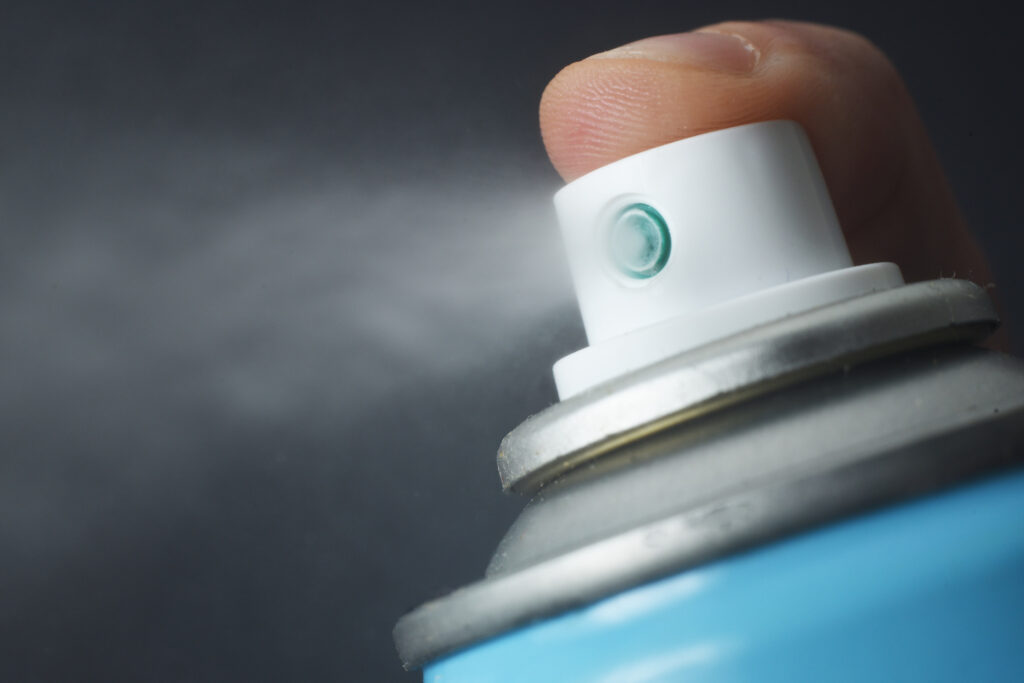When teenagers begin to experiment with heroin, meth or cocaine. Young teens are much more likely to start with inexpensive, legal substances that are found around the house. The vapors of everyday aerosol products like spray paint, hairspray, deodorants and air fresheners can be inhaled, or “huffed,” by kids for a mind-altering high.
The poisonous chemicals found in these pressurized containers can cause not only hazardous short-term effects, but also severe long-term damage to the brain and body. For children and teens, whose brains are still in a vulnerable developmental stage, the abuse of aerosol inhalants can cause permanent, life-altering changes.
What Are Inhalants?
An inhalant is any one of a multitude of commercial or household chemicals that are sniffed or huffed to produce a high. These chemicals contain volatile and dangerous pressurized gas or vapors. When breathed in through the mouth or nose they can have an intoxicating effect. In teen inhalant abuse, these chemicals are clearly used in a manner that is not intended by the makers of such chemicals. Aerosol addiction is an increasingly alarming epidemic in teens because these volatile chemicals are commonly found in the home and easily accessible to teens seeking out a “quick trip” or “high.”
How Do People Use Inhalants?
Kids commonly learn how to get high off aerosol chemicals by observing peers. The act of getting high from aerosols is done by sniffing (also called snorting, huffing, or bagging) the chemicals found in common household goods. Teens can do this by spraying the chemical in a handkerchief or washcloth and inhaling it. Or, teens might spray the chemical in a paper or plastic bag and then inhale (known as “bagging”). Non-aerosol inhalants such as glue are sniffed directly from the container.
Commonly Abused Inhalants
Aerosol inhalant abuse starts at an early age in the United States. According to statistics from the Agency for Toxic Substances and Disease Registry, 17 percent of young people in America have intentionally used inhalants to get high, and 3 percent of American kids have tried inhalants by the age of 9 or 10, or around the 4th grade. Although the chemical compounds in these products may sound foreign, they aren’t hard to obtain; in fact, you probably keep many of them in your bathroom cabinet, under your kitchen sink or in the garage.
Many of the most commonly abused substances belong to a class of compounds called haloalkanes. Haloalkanes — including hydrofluorocarbons, chlorofluorocarbons, trichloroethylene and trichloroethane — are used as solvents or propellants in a variety of commercial aerosols, such as:
- Cleaning products
- Flame retardants
- Lighter fuels
- Degreasers
- Refrigerants
- Spray paints
- Spray adhesives
When used according to instructions in safe conditions, these products are generally not harmful. However, abuse of aerosol inhalants has an immediate effect on the central nervous system. Over time, inhalant abuse can harm the heart, lungs and kidneys as well as the brain.
2 Simple Ways to Get Started Today
“When you call Muir Wood, you will either reach me or one of my staff. Please know that we are 110% committed to helping you find the best treatment for your teen and will hold your hand through the entire process. And if we aren’t an ideal fit for your child, we’ll help you find a program that is.” — Maura “Mo” Sangster, Director of Admissions

Maura “Mo” Sangster
Director of Admissions
Short-Term and Long-Term Risks of Inhalant Abuse
Repeated use has a direct impact on the brain, affecting the areas that control motor coordination, judgment, learning, decision-making and emotions. The British Journal of Pharmacology notes that the quick, repeated inhalation of aerosols — a practice that’s common among teenagers who abuse these products — increases the concentration of chemicals that the body absorbs. A teenager who is sniffing aerosols may inhale the fumes up to 20 times within a 15-minute period, for example, greatly increasing the toxic exposure.
Short-Term Effects of Inhalant Abuse
The short-term effects of aerosol inhalation may include excitement, dizziness, agitation, confusion, poor motor coordination, a rapid heart rate, nausea and slurred speech. In some teens, a single experiment with aerosol inhalants can be deadly. A phenomenon called “sudden sniffing death” can occur when inhaled chemicals cause a sudden increase in a young person’s heart rate, followed by cardiac arrest. According to the Nemours Foundation, most fatalities from inhalant abuse are caused by this phenomenon.
Long-Term Effects of Inhalant Abuse
The long-term effects of inhalant abuse can change the course of a teen’s life. The chemicals in aerosol inhalants are addictive, which means that recreational use can quickly lead to a dangerous habit. Repeated abuse of aerosols can have the following effects on an adolescent’s cognitive and psychological functions:
- Learning delays
- Problem-solving difficulties
- Memory loss
- Slow speech
- Mood swings
- Depression
- Loss of decision-making skills
Can a Person Overdose On Inhalants?
In a word, yes. Anyone, at any age, can overdose on inhalants – no matter if it is their first time or if they’ve been inhaling over a long period of time. So, if you’re wondering why is inhalant use dangerous for teens, the answers are multitudinous – but the risk of overdosing is chief among health concerns of inhalant abuse. This is because an overdose can lead to seizures, choking, blackouts, delirium, coma, or even death.
How to Treat an Inhalant Overdose?
If your teen has stopped breathing or collapsed due to an inhalant overdose, dial 911 immediately. You may have to administer CPR until medical professionals arrive on the scene. To expedite treatment of an overdose, you should try to provide medical professionals with information such as the level of usage, the substance that was inhaled at the time of the overdose, and prior medical history. Be sure to decontaminate your teen by removing the substance from his or her clothing or skin because residuals can still be inhaled. As the physical effects of inhalants attack internal organs and the heart, medical professionals will assess cardiovascular conditions and signs of organ damage. All overdoses are dangerous and can be life-threatening. Therefore, it is crucial to seek medical help immediately after an overdose.
Can Inhalants Lead to Addiction?
Yes. Aerosol addiction is a reality, and can lead to both psychological and physical dependence. You might be wondering what influences teens to use inhalants in the first place. The answers range from peer pressure to seeking out the intoxicating effects. While the reasons teens inhale may vary, the potential for addiction increases the longer a teen continues to abuse inhalants. Because addiction is a very real concern, parents should be proactive in seeking out teen inhalant abuse treatment to avoid mental or physical health hazards, dependency, overdose, or even death in teens.
Warning Signs of Inhalant Abuse?
Some signs of inhalant abuse can be significantly obvious such as finding aerosols or substances commonly inhaled in your child’s room, bookbag, etc. You may also detect substances such as paint, glue, or gasoline on your teen’s face, hands, or clothing. Other signs of teen inhalant abuse that are not as obvious include loss of appetite, anxious behavior, runny nose, red eyes, or acting odd (as in behaving while under the influence of a substance). A teen may also have sores around the nose or mouth if he or she is abusing inhalants.
Signs Your Teen is Huffing?
In addition to the signs of teen inhalant abuse already mentioned, you should also take note of your child’s behavior. If he or she seems unusually hyperactive, edgy, or irritable – this could be a sign of huffing. Alternatively, a teen may express oddly slow behavior, such as acting drunk, slurred speech, or being lethargic or depressed if he or she struggles with aerosol addiction. You may also notice changes in social behavior or activities, such as no longer hanging out with friends or family or participating in activities he or she used to enjoy. Additionally, teens who might have an inhalant abuse problem may begin to show academic struggles such as skipping classes or grades falling in school. As mentioned earlier, physical signs of teen huffing include the evidence of aerosols and inhalants among a teen’s possessions, red or bloodshot eyes, runny nose, weight loss, unkempt or drunken appearance, and odor of aerosols on or around your teen.
Getting the Help You Need For Teen Inhalant Abuse Treatment
At Muir Wood Teen Treatment, we realize that the effects of abusing household aerosols can be just as devastating as the consequences of hard drug use. Our comprehensive treatment programs are designed to help teens between the ages of 12 and 17 recover their health and reclaim their futures. Learn more about the teen conditions we treat at Muir Wood. If you or someone in your life has a problem with inhalants, our treatment specialists can help you decide whether our innovative, gender-specific program is right for you.









